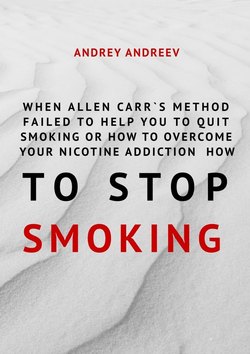Читать книгу When Allen Carr’s method failed to help you to quit smoking or how to overcome Your nicotine addiction, how to stop smoking - Андрей Андреев - Страница 4
На сайте Литреса книга снята с продажи.
2. Why we constantly want to inhale smoke from lit cigarettes
Оглавление2.1. The primary reason is dopamine
Dopamine (DA) is a neurotransmitter produced in the human brain, its production is localized in the hypothalamus. Dopamine is synthesized from the amino acid tyrosine through a subsequent step of L-dioxyphenylalanine. Then, noradrenaline can be produced from dopamine (also in the hypothalamus). Artificially synthesized dopamine, injected into the blood, acts as an activator of cardiovascular activity along with noradrenaline, but this hormone barely penetrates the central nervous system via blood due to the blood-brain barrier (this is also a scientific definition – author’s note).
Dopamine is one of the chemical factors of internal reinforcement (FIR) and serves as an important part of the brain’s “reward system”. Dopamine induces feelings of pleasure (or satisfaction), which affects the processes of motivation and learning. Dopamine is naturally produced in large quantities during subjectively positive experiences such as sex, eating tasty food, and from pleasant bodily sensations. Neurobiological experiments have shown that even reward memories can increase dopamine levels, which is why this neurotransmitter is used by the brain to assess and motivate, reinforcing actions that are important for survival and procreation.
Synthetic analogs. The influence of drugs on dopamine levels
Like most neurotransmitters, dopamine has synthetic analogs as well as stimulators of its release in the brain. In particular, many drugs increase dopamine production and release it into the brain by 5—10 times higher than normal, which allows drug addicts to get a feeling of pleasure through artificial means. Thus, amphetamine directly stimulates dopamine release, affecting the mechanism of its transmission. Other drugs, such as cocaine and some other psychostimulants, block the natural mechanisms of dopamine reuptake, increasing its concentration in the synaptic space. Morphine and nicotine imitate the action of natural neurotransmitters, while alcohol blocks the action of dopamine antagonists. If a patient continues to overstimulate his “reward system”, the brain gradually adapts to the artificially increased dopamine levels, producing less hormone and decreasing the number of receptors in the “reward system”. This is one of the factors that induce an addict to increase the dose to obtain the same effect. Further development of chemical tolerance may gradually lead to metabolic disturbances in the brain and potentially cause serious damage to brain health in the long term.
To illustrate the effect of nicotine on dopamine levels, let’s take a look at their interaction in a graph. Pay particular attention to the yellow line “Degree of dependence on dopamine level stimulation by nicotine”.
Notes to Graph 1.
– Stage 1 begins from the moment of inhaling smoke from that first cigarette or the first instance of secondhand smoke until the first signs of addiction (the appearance of an unconscious rare desire to inhale smoke from a lit cigarette). The duration of the first stage is from one day to a month, depending on the frequency of intake of smoke from lit cigarettes into the human body.
– Stage 2 shows a pronounced, sometimes not yet realized nicotine dependence, which consists of the systematic inhalation of smoke from lit cigarettes (probably, not so frequent – more than once a week), without any noticeable (or pronounced) deterioration to your health. This stage can last for several years.
– Stage 3 shows pronounced features of health deterioration. The duration of this stage depends on the general state of a smoker’s health at the beginning of the “smoking experience”, lifestyle, physical activity, other bad habits, etc. At this stage, changes have already occurred in the smoker’s character and morality: irritation, grumbling, hatred for others, laziness – traits inherent in most smokers, however, laziness is due to physical weakness.
– Stage 4 shows a significant dependence of dopamine production on the presence of nicotine in the blood with significant health deterioration, when inhalation of smoke from lit cigarettes no longer raises dopamine levels to a level that is acceptable for the psyche. The main feature of this stage: a person wants to inhale smoke from lit cigarettes more and more, but their physical condition already limits the consumption of nicotine, because the body is full of poisons.
TO SUM UP, let’s make the following conclusions: inhaling smoke from lit cigarettes increases dopamine levels in the short term (in first-time smokers – for up to 12 hours, in experienced smokers – only for a few minutes), but decreases its overall level with each day of nicotine addiction. One or two months after the start of continuous inhalation of smoke from lit cigarettes, the dopamine level after its increase from nicotine (immediately after the cigarette is extinguished) will be lower than your baseline dopamine levels (when you did not inhale tobacco smoke at all, i.e. when you were not addicted to nicotine). But you can only feel a short-term change in dopamine levels with your whole body, consciousness and subconsciousness! Therefore, you want to smoke (inhale this smoke).
